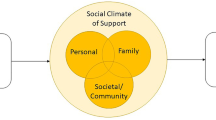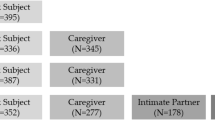Abstract
Research on the mental health and psychosocial wellbeing of children in conflict-affected settings has undergone a significant paradigm shift in recent years. Earlier studies based on a war exposure model primarily emphasized the effects of direct exposure to armed conflict; this has gradually given way to a broader understanding of the diverse pathways by which organized violence affects children. A robustly supported comprehensive model includes risk factors at multiple points in time (prior war exposure, ongoing daily stressors) and at all levels of the social ecology. In particular, findings suggest that material deprivation and a set of family variables, including harsh parenting, parental distress, and witnessing intimate partner violence, are important mediators of the relationship between armed conflict and children’s wellbeing. To date, however, interventions aimed at supporting war-affected children’s wellbeing, both preventive and treatment-focused, have focused primarily on direct work with children, while paying only modest attention to ongoing risk factors in their families and broader environments. Possible reasons for the ongoing prioritization of child-focused interventions are considered, and examples are provided of recent evidence-based interventions that have reduced toxic stressors (harsh parenting and the use of violent discipline by teachers) in conflict-affected communities.
Similar content being viewed by others
References
Papers of particular interest, published recently, have been highlighted as: • Of importance, •• Of major importance
Reed R, Fazel M, Jones L, Panter-Brick C, Stein A. Mental health of displaced and refugee children resettled in low-income and middle-income countries: risk and protective factors. Lancet. 2011;379:250–65. doi:10.1016/S0140-6736(11)60050-0.
Betancourt T, Meyers-Ohki S, Charrow A, Tol WA. Interventions for children affected by war: an ecological perspective on psychosocial support and mental health care. Harvard Review of Psychiatry. 2013;21(2):70–91.
Jordans MJD, Pigott H, Tol WA. Interventions for children affected by armed conflict: a systematic review of mental health and psychosocial support in low and middle-income countries. Current Psychiatry Reports. 2016;18(9). doi:10.1007/s11920-015-0648-z. A systematic review of mental health and psychosocial interventions for children, including a critical discussion of key issues and areas in needed of further research.
Barber BK. Annual research review: The experience of youth with political conflict—challenging notions of resilience and encouraging research refinement. J Child Psychol Psychiatry. 2013;54(4):461–73. doi:10.1111/jcpp.12056. A thoughtful analysis of the resilience and psychopathology literatures concerning children and armed conflict. Challenges key definitional assumptions underlying the concept of resilience.
Masten AS, Narayan A. Child development in the context of disaster, war, and terrorism: pathways of Risk and resilience. Annu Rev Psychol. 2012;63:227–57. doi:10.1146/annurev-psych-120710-100356.
Miller KE, Rasmussen A. War experiences, daily stressors, and mental health five years on: elaborations and future directions. Intervention: International Journal of Mental Health, Psychosocial Work & Counselling in Areas of Armed Conflict. 2014;12:33–42.
Miller KE, Rasmussen A. War exposure, daily stressors, and mental health in conflict and post-conflict settings: bridging the divide between trauma-focuses and psychosocial frameworks. Soc Sci Med. 2010;70:7–16.
Ventevogel P, Jordans MJD, Eggerman M, van Mierlo B, Panter-Brick C. Child mental health, psychosocial well-being and resilience in Afghanistan: a review and future directions. In: Fernando C, Ferrari M, editors. Handbook of resilience in children of war. New Yok: Springer; 2013. p. 51–79. A richly contextualized examination of factors influencing mental health and psychosocial wellbeing among children and families in Afghanistan. Illustrates the power and importance of understanding cultural context in research and practice with children affected by armed conflict and other adversity.
Arroyo W, Eth S. Children traumatized by Central American warfare. In: Pynoos R, Eth S, editors. Post-traumatic Stress Disorder in Children. Washinton, DC: American Psychiatric Press; 1985. p. 101–20.
Fox SH, Tang SS. The Sierra Leonean refugee experience: traumatic events and psychiatric sequelae. Journal of Nervous & Mental Disease. 2000;188(8):490–5.
Kinzie JD, Sack W, Angell R, Clarke G, Ben R. The psychiatric effects of massive trauma on Cambodian children: I. The children. J Am Acad Child Adolesc Psychiatry. 1986;25:370–6.
Garbarino J, Kostelny K. The effects of political violence on Palestinian children’s behavior problems: a risk accumulation model. Child Dev. 1996;67(1):33–45.
Gibson K. Children in political violence. Soc Sci Med. 1989;28:659–67.
Al Krenawi A, Lev-Wiesel R, Sehwail M. Psychological symptomatology among Palestinian children living with political violence. Child Adolesc Mental Health. 2007;12:27–31.
Catani C, Schauer E, Neuner F. Beyond individual war trauma: domestic violence against children in Afghanistan and Sri Lanka. Journal of Marital & Family Therapy. 2008;34:165–76.
Miller KE, Fernando GA, Berger DE. Daily stressors in the lives of Sri Lankan youth: a mixed methods approach to assessment in a context of war and natural disaster. Intervention: International Journal of Mental Health, Psychosocial Work and Counseling in Areas of Armed Conflict. 2009;7:187–203.
Olema DK, Catani C, Ertl V, Saile R, Neuner F. The hidden effects of child maltreatment in a war region: correlates of psychopathology in two generations living in Northern Uganda. J Trauma Stress. 2014;27:1–7. doi:10.1002/jts.21892.
Panter-Brick C, Goodman A, Tol WA, Eggerman M. Mental health and childhood adversities: a longitudinal study in Kabul, Afghanistan. J Am Acad Child Adolesc Psychiatry. 2011;50:349–63.
Fernando GA, Miller KE, Berger DE. Growing pains: the impact of disaster-related and daily stressors on the psychological and psychosocial functioning of youth in Sri Lanka. Child Dev. 2010;81(4):1192–210.
Khamis V. Does parent’s psychological distress mediate the relationship between war trauma and psychosocial adjustment in children? Journal of Health Psychology. 2014. doi:10.1177/1359105314553962. Documents the mediating role of paternal distress in the relationship between political violence and children’s mental health in Palestine.
Palosaari E, Punamäki RL, Quota S, Diab M. Intergenerational effects of war trauma among Palestinian families mediated via psychological maltreatment. Child Abuse Negl. 2013;37(11):955–68.
Jordans MJD, Semrau M, Thornicroft G, van Ommeren M. Role of current perceived needs in explaining the association between past trauma exposure and distress in humanitarian settings in Jordan and Nepal. Br J Psychiatry. 2012;201:276–81.
Rasmussen A, Nguyen L, Wilkinson J, Vundla S, Raghavan S, Miller KE, et al. Rates and impact of trauma and current stressors among Darfuri refugees in Eastern Chad. Am J Orthopsychiatry. 2010;80:227–36. doi:10.1111/j.1939-0025.2010.01026.x.
Hossain M, Zimmerman C, Watts C. Preventing violence against women and girls in conflict. Lancet. 2014;383:2021–2. doi:10.1016/S0140-6736(14)60964-8.
Saile R, Ertl V, Neuner F, Catani C. Does war contribute to family violence against children? Findings from a two-generational multi-informant study in Northern Uganda. Child Abuse Negl. 2013;38:135–46. doi:10.1016/j.chiabu.2013.10.007.
Panter-Brick C, Grimon M, Eggerman M. Caregiver-child mental health: a prospective study in conflict and refugee settings. J Child Psychol Psychiatry. 2014;55(4):313–27. doi:10.1111/jcpp.12167.
Miller KE. War torn: stories of courage, love, and resilience. Burdett, NY: Larson Publications; In press.
Ungar M, Ghazinour M, Richter J. What is resilience within the ecology of human development? J Child Psychol Psychiatry. 2013;54:348–66.
Tol WA, Song S, Jordans MJD. Annual Research Review: Resilience and mental health in children and adolescents living in areas of armed conflict—a systematic review of findings in low‐ and middle‐income countries. J Child Psychol Psychiatry. 2013;54(4):445–60.
Betancourt T, Salhi C, Buka S, Leaning J, Dunn J, Earls F. Connectedness, social support and internalising emotional and behavioural problems in adolescents displaced by the Chechen conflict. Disasters. 2011;36:635–55.
Dubow EF, Huesmann LR, Boxer P, Landau S, Dvir S, Shikaki K, et al. Exposure to political conflict and violence and posttraumatic stress in Middle East youth: protective factors. J Clin Child Adolesc Psychol. 2012;41(4):402–16. doi:10.1080/15374416.2012.684274.
Morley CA, Kohrt B. Impact of peer support on PTSD, hope, and functional impairment: a mixed-methods study of child soldiers in Nepal. J Aggress Maltreat Trauma. 2013;22:714–34. doi:10.1080/10926771.2013.813882.
Jordans MJD, Tol WA, Komproe IH, de Jong JTVM. Systematic review of evidence and treatment approaches: psychosocial and mental health care for children in war. Child Adolesc Mental Health. 2009;14:2–14.
Tyrer R, Fazel M. School and community-based interventions for refugee and asylum seeking children: a systematic review. PLoS ONE. 2014;9(2). doi:10.1371/journal.pone.0089359. An excellent systematic review documenting strengths and empirical gaps in the evidence base for school and community-based interventions of children displaced by armed conflict.
McLoyd V. Socioeconomic disadvantage and child development. Am Psychol. 1998;53(2):185–204.
Hobfoll S. Resource caravans and resource caravan passageways: a new paradigm for trauma responding. Intervention: International Journal of Mental Health, Psychosocial Work & Counselling in Areas of Armed Conflict. 2014;12:21–32.
Kubiak S. Trauma and cumulative adversity in women of a disadvantaged social location. Am J Orthopsychiatry. 2005;75:451–65.
Herman JL. Trauma and recovery: the aftermath of violence—from domestic abuse to political terror. New York: Basic Books; 1992.
O’Callaghan PS, McMullen J, Shannon C, Rafferty H, Black A. A randomized controlled trial of trauma-focused cognitive behavioral therapy for sexually exploited, war-affected Congolese girls. Journal of the American Academy of Child & Adolescent Psychiatry. 2013;52(4):359–69. doi:10.1016/j.jaac.2013.01.013. An RCT of a CBT-based intervention that integrated livelihood training, caregiver support, and trauma treatment for sexually exploited Congolese girls. Found unusually large treatment effect sizes that were still present at three month follow up.
Ager A, Akesson B, Stark L, Flouri E, Okot B, McCollister F, et al. The impact of the school-based Psychosocial Structured Activities (PSSA) program on conflict-affected children in northern Uganda. J Child Psychol Psychiatry. 2011;52(11):1124–33. doi:10.1111/j.1469-7610.2011.02407.x.
Miller KE, Billings DL. Playing to grow: a primary mental health intervention with Guatemalan refugee children. Am J Orthopsychiatry. 1994;64(3):346–56. doi:10.1037/h0079548.
Dybdahl R. Children and mothers in war: an outcome study of a psychosocial intervention program. Child Dev. 2001;72(4):1214–30.
Jordans M, Tol W, Ndayisaba A, Komproe I. A controlled evaluation of a brief parenting psychoeducation intervention in Burundi. Social Psychiatry and Psychiatric Epidemiology. 2012:1-9.
Sim A, Annan J, Puffer E, Salhi C, Betancourt T. Building happy families: impact evaluation of a parenting and family skills intervention for migrant and displaced Burmese families in Thailand. New York: International Rescue Committee; 2014. Demonstrated a significant reduction in harsh parenting and a corresponding improvement in children’s wellbeing, working solely with parents.
Sim A, Puffer E, Green E, Chase R, Zayzay J, Garcia-Rolland E, et al. Parents make the difference: findings from a randomized impact evaluation of a parenting program in rural Liberia. New York: International Rescue Committee; 2014.
Devries KM, Knight L, Child JC, Mirembe A, Nakuti J, Jones R, et al. The good school toolkit for reducing physical violence from school staff to primary school students: a cluster-randomised controlled trial in Uganda. Lancet Global Health. 2015;385:378–86. An intriguing RCT of an intervention that showed a significant reduction in teachers’ use of violent punishment with students in Uganda.
Author information
Authors and Affiliations
Corresponding author
Ethics declarations
Conflict of Interest
The authors declare that they have no conflict of interest.
Human and Animal Rights and Informed Consent
This article does not contain any studies with human or animal subjects performed by any of the authors.
Additional information
This article is part of the Topical Collection on Child and Family Disaster Psychiatry
Rights and permissions
About this article
Cite this article
Miller, K.E., Jordans, M.J.D. Determinants of Children’s Mental Health in War-Torn Settings: Translating Research Into Action. Curr Psychiatry Rep 18, 58 (2016). https://doi.org/10.1007/s11920-016-0692-3
Published:
DOI: https://doi.org/10.1007/s11920-016-0692-3




